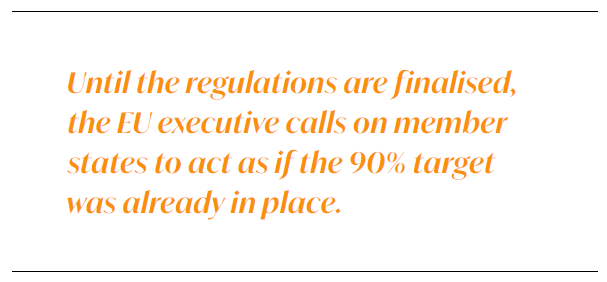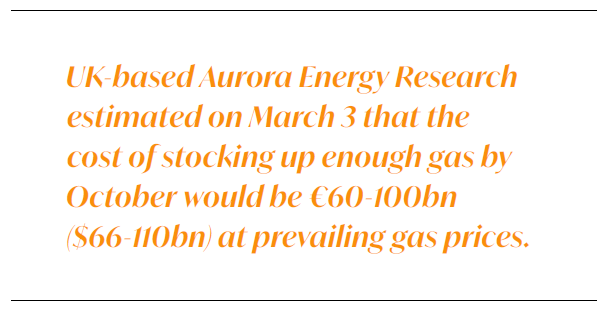Brussels plans gas storage requirements to ward off supply risks [Gas in Transition]
Given the significant threat low levels of gas stock posed in the winter that is just ending, the European Commission is preparing legislation that will require EU member states to fill their storage facilities to 90% by October 1. But the move comes against a backdrop of soaring prices, and so implementing the plan will likely prove very expensive, especially considering the bloc is also targeting a significant cut in Russian gas imports this year.
The EU entered the 2021-22 winter heating season on October 21 last year with its 117bn m3 of gas storage capacity only 77.4% full. This meant that there was 7bn m3 less gas than the previous record low for start of withdrawals, in 2018. By mid-December, it had already dropped to under 60%, prompting fears of shortages during winter’s tail end. Yet Europe was spared from rolling blackouts and heating losses, thanks to a jump in LNG imports and higher-than-expected temperatures. Nevertheless, the market’s tightness over the coldest months of the year meant soaring prices, prompting some consumers to cut their usage, and creating a drag on the EU’s post-COVID recovery.
Brussels began discussing the introduction of stricter controls of gas storage levels well before Russia began its invasion of Ukraine in late February. With the added risk of a potential disruption in Russian gas supply if the conflict escalates, and in light of EU efforts to scale down Russian imports anyway, the European Commission (EC) wants extra policies in place to safeguard the bloc’s energy security.
The EC will not publish its legislative proposal on gas storage until April, and after that it will be scrutinised by EU member states and lawmakers. But until the regulations are finalised, the EU executive calls on member states to act as if the 90% target was already in place.
What is known so far is that the commission will propose increasing the tariff rebate at storage points to 100%, to provide companies with an extra incentive to refill storage. The policy will take into account that not all member states have storage facilities, and the EC aims to create a mechanism for ensuring a fair allocation of security of supply costs. The commission also notes that the benefits of having high storage utilisation should be shared, which might mean new interconnectors are needed to ensure uninterrupted energy flow within the bloc. But if new infrastructure is needed, it should be hydrogen compatible.
The commission wants to list gas storage facilities as critical infrastructure and this will mean safeguarding against ownership risks. This is primarily a reference to Russia’s Gazprom, which operates nearly one tenth of EU gas storage capacity, most of which is in Germany, the biggest market for Russian gas in Europe. The EC states that “member states will have to require the regulatory authority or another competent authority designed by the member state to certify that ownership by a person or persons from a third country does not put at risk the security of supply.” This requirement will apply to all existing and future storage operators, and again, member states should act as if the legislation was already in place.
In the months leading to Russia’s invasion of Ukraine, Brussels criticised Gazprom not putting enough gas in its storage sites, exacerbating security concerns. Indeed, the commission notes that the average storage utilisation of Gazprom-operated facilities is only 16%, whereas for non-Gazprom storage sites, the utilisation is 44%. The commission said that it had prioritised an investigation into the Russian company over potential anti-competitive actions, and was gathering information for the case from market players.
While the question of storage owners jeopardising supply security is primarily directed towards Gazprom, other operators will also be compelled to follow the rules to avoid falling afoul of regulators.
In addition, the commission said it stood ready to help coordinate refilling operations, through for example joint procurement, collecting orders and matching supplies.
Prudent but costly
Amid escalating tensions with Russia over the invasion, and considering low utilisation levels in the 2020-21 season, Brussels’ push for greater oversight seems a prudent one. After all, up to 30% of the gas that the EU uses during winter comes from storage.
Thierry Bros, energy expert and professor at Sciences Po Paris, notes that the storage trend this month already seems to indicate that the market has factored in the EC’s 90% target, predicting that storage operators will comply through fear of having their assets nationalised.
“Even if the winter-summer spread doesn’t incentivise refilling storage, the risk of not meeting this target when states have permanent sovereignty over natural resources and by extension over gas storage is too high,” he says. “ The state reaction could lead up to full nationalisation if the target is not achieved.”
Nevertheless, he expects European utilities facing these extra obligations to ask for subsidies to cover the added cost.
However, getting to 90% capacity will be a colossal undertaking, given the high price and scarcity of gas supply right now. It will be even more difficult considering the EU is in tandem looking to phase out its Russian gas purchases drastically this year, potentially by as much as two thirds.
Indeed, UK-based Aurora Energy Research estimated on March 3 that the cost of stocking up enough gas by October would be €60-100bn ($66-110bn) at prevailing gas prices. After a further spike in gas prices to over €200/MWh over the following week, it estimated the cost at €150bn, although the TTF front-month price is now trading at closer to €100/MWh. Clearly price volatility makes it hard to calculate the cost, but as the consensus is that prices will remain elevated at similar levels to today, given the EU’s desire to shut out Russian gas, this cost is sure to be significant, meaning government intervention may be necessary.



